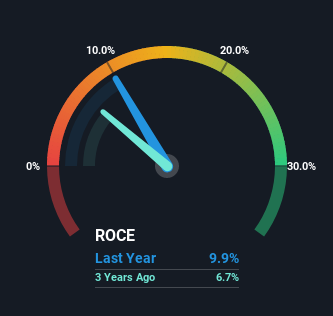
Did you know there are some financial metrics that can provide clues of a potential multi-bagger? Ideally, a business will show two trends; firstly a growing return on capital employed (ROCE) and secondly, an increasing amount of capital employed. Basically this means that a company has profitable initiatives that it can continue to reinvest in, which is a trait of a compounding machine. Having said that, from a first glance at Pets at Home Group (LON:PETS) we aren't jumping out of our chairs at how returns are trending, but let's have a deeper look.
Return On Capital Employed (ROCE): What Is It?
Just to clarify if you're unsure, ROCE is a metric for evaluating how much pre-tax income (in percentage terms) a company earns on the capital invested in its business. Analysts use this formula to calculate it for Pets at Home Group:
Return on Capital Employed = Earnings Before Interest and Tax (EBIT) ÷ (Total Assets - Current Liabilities)
0.099 = UK£145m ÷ (UK£1.8b - UK£310m) (Based on the trailing twelve months to March 2022).
Thus, Pets at Home Group has an ROCE of 9.9%. In absolute terms, that's a low return and it also under-performs the Specialty Retail industry average of 14%.
View our latest analysis for Pets at Home Group

Above you can see how the current ROCE for Pets at Home Group compares to its prior returns on capital, but there's only so much you can tell from the past. If you'd like, you can check out the forecasts from the analysts covering Pets at Home Group here for free.
So How Is Pets at Home Group's ROCE Trending?
There are better returns on capital out there than what we're seeing at Pets at Home Group. Over the past five years, ROCE has remained relatively flat at around 9.9% and the business has deployed 28% more capital into its operations. Given the company has increased the amount of capital employed, it appears the investments that have been made simply don't provide a high return on capital.
What We Can Learn From Pets at Home Group's ROCE
As we've seen above, Pets at Home Group's returns on capital haven't increased but it is reinvesting in the business. Since the stock has gained an impressive 99% over the last five years, investors must think there's better things to come. Ultimately, if the underlying trends persist, we wouldn't hold our breath on it being a multi-bagger going forward.
One more thing to note, we've identified 2 warning signs with Pets at Home Group and understanding these should be part of your investment process.
If you want to search for solid companies with great earnings, check out this free list of companies with good balance sheets and impressive returns on equity.
New: Manage All Your Stock Portfolios in One Place
We've created the ultimate portfolio companion for stock investors, and it's free.
• Connect an unlimited number of Portfolios and see your total in one currency
• Be alerted to new Warning Signs or Risks via email or mobile
• Track the Fair Value of your stocks
Have feedback on this article? Concerned about the content? Get in touch with us directly. Alternatively, email editorial-team (at) simplywallst.com.
This article by Simply Wall St is general in nature. We provide commentary based on historical data and analyst forecasts only using an unbiased methodology and our articles are not intended to be financial advice. It does not constitute a recommendation to buy or sell any stock, and does not take account of your objectives, or your financial situation. We aim to bring you long-term focused analysis driven by fundamental data. Note that our analysis may not factor in the latest price-sensitive company announcements or qualitative material. Simply Wall St has no position in any stocks mentioned.
About LSE:PETS
Pets at Home Group
Engages in the specialist omnichannel retailing of pet food, pet related products, and pet accessories in the United Kingdom.
Solid track record established dividend payer.
Market Insights
Community Narratives



